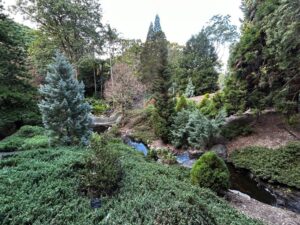
Conifers for warm climates showcased at Mt Coot-tha
By Dale Arvidsson
Conifers are among the oldest and most diverse groups of plants on Earth. They have existed and evolved for more than 300 million years, surviving ice ages, changing climates, and mass extinctions. These plants have adapted to a wide range of habitats, living just above sea level in the tropics to over 3000 metres in altitude and above the timberline of the world’s highest mountain ranges. From arctic tundra to deserts, conifers occur on all continents except Antarctica, and offer food and habitat for both wildlife and people, and are the source of many valuable products such as timber, paper, jewellery and medicine.
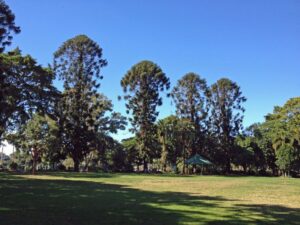
The most diverse selection of conifers atBrisbane Botanic Gardens Mt Coot-tha arehoused in the Conifer Collection,with a number of sub-collections also found across the Mt Coot-tha Gardens’ 56ha site. Conifers are also a key element of Brisbane’s two other botanic collections – the historic City Botanic Gardens and Sherwood Arboretum, both of which house ‘Pinetum’ collections of conifers.
Growing conifers in Brisbane
Conifers are typically slow growing in colder climates, however, as Brisbane does not have a true cold dormant season, conifers in our collections grow consistently all year round. For some conifers this ultimately shortens their lifespan in cultivation. For example, the Kashmir Cypress, Cupressus cashmeriana, typically experiences a faster growing and much-shortened lifespan of under 20 years in Brisbane, compared to the more typical 60+ years common in temperate climate areas where this species naturally occurs. Other conifers, such as the iconic Bunya Pine Araucaria bidwillii, Hoop Pine Araucaria cunninghamii and Queensland Kauri Pine Agathis robusta have been successfully growing in Brisbane’s City Botanic Gardens since the 1850’s and most likely have many hundreds of years of lifespan ahead of them.
The Conifer Collection

The ‘Conifer Garden’ was developed at Mt Coot-tha in 1985. The site was selected due to its steeply sloping terrain for good drainage and sunny north-western aspect, to successfully trial and display conifers in the subtropics.
Originally, the collection was principally comprised of exotic conifers from the Northern Hemisphere along with some taxa from the Pacific, such as New Caledonia. Over time, several of the Northern Hemisphere conifers have proven to be unsuccessful in Brisbane’s subtropical heat and humidity, which typically sees seasonal reverses of abundant summer rain and a dry winter/spring – the opposite to where many northern hemisphere conifers naturally grow. In response to this, a collection change to include species and cultivars that are known to grow well in subtropical climates is now the collection’s core sustainable basis. The collection also holds several significant, and threatened with extinction in the wild, taxa.
Designed to provide a varied and pleasing aspect, the collection is divided into three amenity horticultural forms which provide a layered and beautiful overall display:
- Groundcovers – a wide range of low growing juniper species and cultivars are displayed here. They are slow growing and have a dense, spreading habit.
- Shrubs and Screens – several taxa have been repeated throughout to create a visual break in sightlines and display these conifer’s screening habit.
- Trees – large trees have been limited to the fringes of the garden area to maximise available sunlight to the collection. Specimen Araucaria and Agathis, followed by CupressusandTaxodium offer the greatest height in the Conifer Collection.
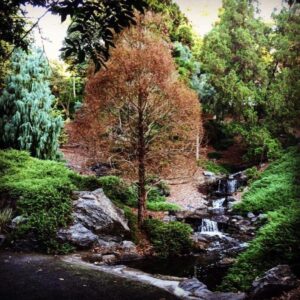
Key families represented in the collection include Araucariaceae, Cupressaceae, Pinaceae, Podocarpaceae and Taxaceae. Some key trees in the collection include:
Dawn Redwood Metasequoia glyptostroboides
A slow growing tree in the Cupressaceae family, it is the sole living species in the genus Metasequoia. In autumn the foliage turns a surprising golden brown before becoming deciduous over winter, whilst in spring new growth flushes pink/red before changing to green.
Native to China, where it is found along what are now cultivated river valleys or in the moist bottoms of ravines, this conifer occurs in the wild only in wet river and stream valleys in the border region of Hubei and Hunan provinces, and Chongqing in south-central China.
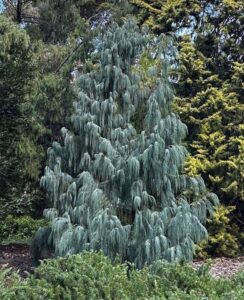
It is classified as Endangered by the IUCN (International Union for Conservation of Nature), though is today widely grown in cultivation.
Kashmir Cypress Cupressus cashmeriana
Featuring beautiful pendulous, silvery foliage, this tree can grow to 45 m in the wild, but typically only reaches 7-10 m in cultivation at the Gardens.
Native to the East Himalaya in Northeast India, Kashmir Cypress has a history of exceptionally fast growth, tempered with a shorter lifespan at Mt Coot-tha.
However, this stunning beauty is worth its program of replacement every 20 years or so due to the colour and contrast of foliage and form not often seen in Brisbane gardens.
Blue Kauri Pine Agathis atropurpurea

The Blue or Black Kauri Pine is a large emergent rainforest tree in the family Araucariaceae, that grows up to 50 m in height. Like all native kauri pines, the trunk is cylindrical and very straight, with smooth to flaky bark that, in the case of this species, is mottled with dark blue, purple, and almost black patches.
The range of this species is confined to a number of small and fragmented populations within Queensland’s Wet Tropics, in the high altitude, microphyll forests that occur north and south of Cairns, including the Bellenden Ker Range, Mt Lewis National Park west of Mossman, Mt Pieter Botte near Cape Tribulation, and the high ranges of the western Atherton Tablelands.
Mt Spurgeon Black Pine Pectinopitys ladei
Formerly known as Prumnopitys ladei, this tree in the Podocarpaceae family can grow 10-25 m tall in the wild. This species only occurs in remnant rainforest on Mt. Spurgeon, Mt. Lewis and the Mt Carbine regions in the Wet Tropics at elevation.
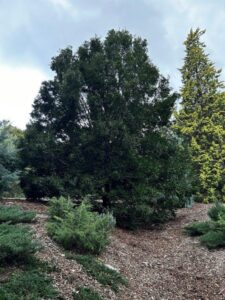
Having such a narrow natural range, it is surprising that this conifer has shown itself to be extremely resilient in horticulture, growing across a wide variety of climates (tropical to temperate) and soil moisture availability, and able to take both very damp and quite dry conditions.
Excellent for horticultural use as a slow growing specimen or for screen planting, this tree often maintains its vegetation on lower limbs even after 30 years, as can be seen with our specimens.
Klinki Pine Araucaria hunsteinii
Klinki Pine is a tree in the Araucariaceae family and is native to the mountains of Papua New Guinea. It is an exceptionally large evergreen tree; the tallest in New Guinea, and the tallest species in its family, growing to 50-80 m tall, and purportedly on occasion to 90 m tall.
With its pyramidal crown that becomes open and flattened with age, it is said to resemble the better-known native Bunya Pine in appearance, however the Garden’s horticultural team report that the dried leaves of this conifer are even sharper than Bunya Pine!
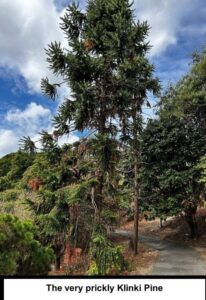
Dale Arvidsson,
Curator, Brisbane Botanic Garden and High Profile Parks
Brisbane City Council
E: dale.arvidsson@brisbane.qld.gov.au
References
Mt Coot-tha Library, Brisbane City Council.
Aljos Farjon, Conifers of the World website and database: https://herbaria.plants.ox.ac.uk/bol/conifers BRAHMS Online. © 1985 – 2023 Department of Plant Sciences, University of Oxford.
Christopher J. Earle, The Gymnosperm Database website https://www.conifers.org/ © 2024.
Queensland Government Species Information webpages https://www.qld.gov.au/environment/plants-animals/species-information © The State of Queensland 1995–2024.
Wikipedia the Free Encyclopedia www.wikipedia.org
All images supplied by Brisbane Botanic Garden
